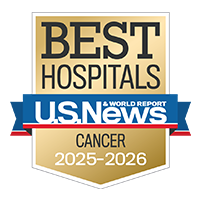Larynx Cancer

Overview
Larynx cancer, also called laryngeal cancer, occurs when malignant cells form in the tissues of the larynx. Many cancers of the larynx, which is part of the respiratory tract, begin in the vocal cords.
Our Approach to Larynx Cancer
UCSF offers cutting-edge diagnostic and treatment options for larynx cancer, delivered in a comfortable and supportive environment. Our goal is to eliminate the cancer while preserving speech and swallowing functions as much as possible.
To achieve the best outcome for each patient, our team includes a wide range of specialists. These include head and neck surgeons, otolaryngologists, medical oncologists, reconstructive surgeons and radiation oncologists, as well as experts in speech-language pathology, nutrition and psycho-oncology, which focuses on psychological factors affecting cancer patients.
Awards & recognition
-

Among the top hospitals in the nation
-

Best in California and No. 7 in the nation for cancer care
-

One of the nation's best for ear, nose & throat care
-

Designated comprehensive cancer center
Signs & symptoms
The symptoms of cancer of the larynx depend mainly on the size and location of the tumor.
- Most cancers of the larynx begin on the vocal cords. These tumors are seldom painful, but they almost always cause hoarseness or other changes in the voice.
- Tumors in the area above the vocal cords may cause a lump on the neck, a sore throat or an earache.
- Tumors that begin in the area below the vocal cords are rare and can make it hard to breathe. Your breathing may become noisy.
A cough that doesn't go away or the feeling of a lump in the throat may also be warning signs of cancer of the larynx. As the tumor grows, it may cause pain, weight loss, bad breath, and choking on food. In some cases, a tumor in the larynx can make it hard to swallow.
Diagnosis
In addition to checking general signs of health, your doctor will carefully feel your neck to check for lumps, swelling, tenderness or other changes. Your doctor also can look at the larynx in two ways:
- Indirect Laryngoscopy Your doctor looks down your throat with a small, long-handled mirror, or through the nose with a flexible telescope, to check for abnormal areas and to see if the vocal cords move as they should. This test is performed in the doctor's office and is painless, but a local anesthetic may be sprayed in the throat or nose to avoid discomfort and prevent gagging.
- Direct Laryngoscopy Your doctor inserts a lighted tube, called a laryngoscope, through your mouth. As the tube goes down the throat, your doctor can look at areas that cannot be seen in the office. This procedure is done in the operating room with use of a general anesthetic to put you to "sleep."
If abnormal areas are found, you will need a biopsy. A biopsy is the only sure way to know if cancer is present. A pathologist examines the tissue under a microscope to check for cancer cells. If cancer is found, the pathologist can determine its type. Almost all cancers of the larynx are squamous cell carcinomas. This cancer begins in the flat, scale-like cells that line parts of the larynx.
Imaging such as computed tomography (CT) scan and magnetic resonance imaging (MRI) are used to determine the extent of the tumor and the status of lymph nodes in the neck.
Treatments
Cancer of the larynx is usually treated with surgery or radiation therapy, also called radiotherapy. Some patients may receive chemotherapy at the time of radiation therapy.
Radiation Therapy
Radiation therapy uses high-energy rays to damage cancer cells and stop them from growing. The rays are aimed at the tumor and the surrounding area. Doctors may suggest this type of treatment for some cancers because it can destroy the tumor and you may not lose your voice.
Radiation therapy may be combined with surgery to destroy microscopic cancer cells that may remain in the area after surgery. Radiation therapy also may be used for tumors that cannot be removed with surgery.
Surgery
Surgery may be recommended as primary treatment for some tumors, thus avoiding radiation. Surgery followed by radiation is suggested for some patients with advanced cancers. Surgery is the usual treatment if a tumor does not respond to radiation therapy or grows back after radiation therapy.
When patients need surgery, the type of operation depends mainly on the size and exact location of the tumor. If a tumor on the vocal cord is very small, the surgeon may use a laser, a powerful beam of light, to remove the tumor. Surgery to remove part or the entire larynx is called a partial or total laryngectomy.
The surgeon may perform a tracheostomy, creating an opening called a stoma in the front of the neck, which may be temporary or permanent. Air enters and leaves the trachea and lungs through this opening. A tracheostomy tube, sometimes called a "trach tube," keeps the new airway open.
A partial laryngectomy preserves the voice. The surgeon removes only part of the voice box — just one vocal cord, part of a cord or just the epiglottis, cartilage that projects upward behind the tongue. In these cases, the tracheostomy is temporary. After a brief recovery period, the trach tube is removed and the opening closes.
In a total laryngectomy, the whole voice box is removed and the stoma or opening is permanent. The patient breathes through the stoma and must learn to talk in a new way.
If your doctor thinks the cancer may have spread, the lymph nodes in the neck and some of the tissue around them may be removed. These nodes are often the first place the laryngeal cancer spreads.
Chemotherapy
Chemotherapy is the use of drugs to kill cancer cells. Your doctor may suggest one drug or a combination of drugs. In some cases, anticancer drugs are given during radiation therapy. Chemotherapy also may be used for cancers that have spread elsewhere in the body.
UCSF Health medical specialists have reviewed this information. It is for educational purposes only and is not intended to replace the advice of your doctor or other health care provider. We encourage you to discuss any questions or concerns you may have with your provider.
More treatment info
-

Brachytherapy (HDR & LDR)
Radioactive material is placed inside a tumor or very close to it to treat the tumor and spare healthy tissue.
Learn more -

Intensity-modulated radiation therapy (IMRT)
The advanced technique focuses strong radiation on the tumor and spares surrounding healthy tissue.
Learn more
Recommended reading
Where to get care (3)
Related clinics (4)

Osher Center for Integrative Health
 2
2





























